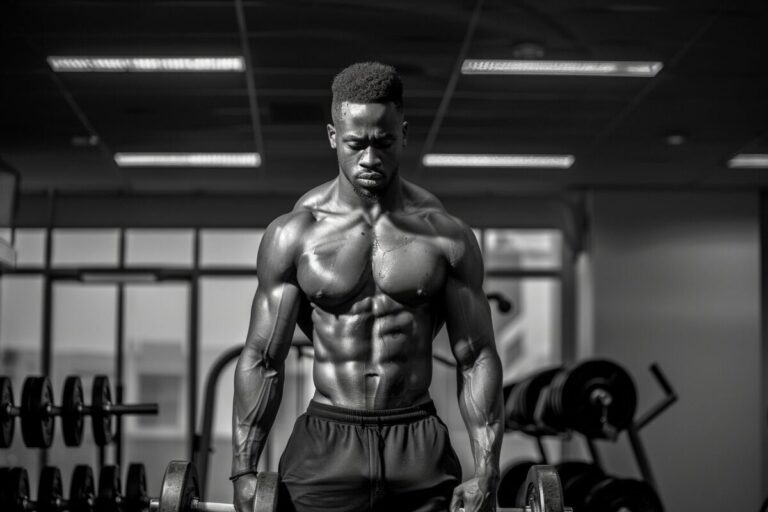Have you ever been mid-pull on the lat pulldown machine, feeling the burn and pushing through the reps, only to realize that it’s not just your back that’s working overtime, but your triceps are also screaming at you?
If that sounds familiar, you’re not alone. It’s a bit like expecting to get a chocolate chip cookie and biting into an oatmeal raisin instead—not necessarily a bad thing, but certainly not what you were aiming for.
The lat pulldown is a staple in many fitness enthusiasts’ routines, specifically designed to target those broad latissimus dorsi muscles that give your back that coveted V-shape. But sometimes, despite our best intentions, our bodies seem to have a mind of their own, and we feel the effort creeping into our triceps.
Why does this happen? Is it a sign of doing something wrong, or is it just part of the exercise?
We’re going to get into the nitty-gritty of why you feel lat pulldowns in your triceps and what you can do to ensure your lats are getting the workout they deserve, as they should. So, grab a protein shake, get comfy, and let’s get to the bottom of this muscle mystery.
Key Things to Know:
- The lat pulldown primarily targets the latissimus dorsi, but improper form can lead to unintended triceps engagement.
- Factors like using too much weight, incorrect elbow positioning, and lack of shoulder stability can shift effort to the triceps.
- Proper hand position, elbow movement, and maintaining a mind-muscle connection are essential for effective lat pulldowns.
- Alternative exercises like dumbbell rows and grip variations in pulldowns can help focus on the back and reduce triceps strain.
Understanding Lat Pulldowns
When you’re at the gym, pulling down that bar during a lat pulldown, have you ever wondered why sometimes your triceps also feel like they’re getting a workout? Let’s look at this exercise and understand exactly which muscles you’re engaging.

Target Muscles in Lat Pulldowns
The star of the lat pulldown is the latissimus dorsi, which is the broadest muscle in your back and one of the largest in your body. As you pull the bar down, these lats are primarily responsible for the downward motion of your arms. They work alongside other muscles, such as the biceps, to ensure a fluid movement that primarily targets your upper back.
Mechanics of the Exercise
Imagine you’re setting up for the exercise. You reach up and grasp the bar with a wide grip. As you pull the bar down towards your chest, your shoulder blades retract and your elbows point straight down to the floor. This arm movement is crucial as it ensures the engagement of the correct muscles.
The lat pulldown is designed to mimic a pull-up, where the focus is on your upper body, pulling strength.
Role of the Triceps in Lat Pulldowns
Now here’s a surprise – your triceps also join the party, but more as a supporting act. The long head of the triceps has a role in extending the arm and stabilising the shoulder joint.
During the lat pulldown, particularly when you’re using a narrow grip or leaning back a bit, you might find that this part of your triceps gets a bit of a workout too. It’s not the main event, but it’s involved in the process nonetheless.
Anatomical And Biomechanical Insights
When you’re doing lat pulldowns, it’s not just your lats that are putting in the work—other muscles play supporting roles too. Understanding the finer points of muscle engagement can help explain why you might feel the burn in unexpected areas like your triceps.
Muscles Engaged In Lat Pulldowns
Lat pulldowns are a compound exercise that primarily target your latissimus dorsi, the large muscles of your back. These are the prime movers in the movement, responsible for the adduction, extension, and internal rotation of the shoulder.
But there’s more to the story. Your triceps, specifically the long head, also play a role in shoulder extension. When pulling the bar down, the triceps assist in stabilising the movement, particularly the elbow joint, resulting in some degree of muscle activation.
It’s why, during heavy lifts or when form starts to slip, you might notice your triceps feeling the strain.
Teres Major And Rhomboids In Back Movements
Now, let’s not forget other key back muscles in the mix. The teres major is often considered the little helper to the latissimus dorsi, aiding in the same movement patterns. Meanwhile, your rhomboids are on standby, working to retract the scapula.
Together with the lats, they create a symphony of muscle anatomy action that enables you to perform the pulldown with precision. Proper form ensures these muscles work together efficiently, without overtaxing any one group, including your triceps.
Common Reasons for Triceps Engagement
When you’re doing lat pulldowns, feeling it in your triceps rather than your lats might leave you a bit puzzled. This usually points to factors such as weight selection, elbow positioning, and shoulder stability. Understanding these common culprits can guide you to adjust your technique for a more effective lat workout.
Using Too Much Weight
Selecting the correct weight is crucial in targeting the latissimus dorsi, the broadest muscle of the back. If the weight is too heavy, there’s a natural inclination to enlist other muscles, like the triceps, to help.
This not only shifts the focus away from your lats but can also lead to muscle fatigue and triceps strain.
Instead of maxing out at 7-8 reps and bringing in your triceps and other supporting muscles, try using a weight that allows you to work in a 15+ rep range allows for a full range of motion and proper form.
Avoiding Overextension Of The Elbows
You might not realise it, but how you extend your elbows during the movement can impact where you feel the burn. If you’re overextending at the bottom of the movement, stop just short to keep the tension on your lats and avoid shifting it to your triceps.
Proper elbow positioning helps maintain good posture and prevents overcompensation by the triceps.
Maintaining Shoulder Stability
The role of shoulder stability in lat pulldowns is often underrated. If you let your shoulder blades rise towards your ears or your shoulders roll forward, your triceps may jump in to compensate for the lack of stability.
Imagine squeezing your shoulder blades down and together, as if tucking them into your back pockets. This advice about maintaining shoulder stability underscores the need for proper grip technique and alignment throughout the exercise.
Analyzing Proper Form
When it comes to lat pulldowns, performing the move with proper form is crucial. Getting it right ensures that the lats, rather than the triceps, do the bulk of the work.
Correct Hand Position And Grip
The hand position on the bar is critical. For a standard lat pulldown, your grip should be just wider than shoulder-width. Thumbs can wrap around the bar or sit atop it—called a “hook grip.”
Remember, your grip affects which muscles are activated. A grip that’s too narrow or too wide will shift the focus away from the lats. Ever tried pulling the bar with your hands too close and felt it more in your arms than your back? Exactly why hand placement matters so much!
Elbow Movement And Posture
The pathway of your elbows can significantly influence muscle engagement. Rather than pulling from the hands, think about driving your elbows down towards your hips. This subtle shift in focus can help engage the lats more effectively.
Posture also plays a role. Sit tall with a slight arch in your lower back, and avoid leaning too far back as this can engage the triceps undesirably and reduce the stretch on the lats.
Mind-Muscle Connection
Lastly, the mind-muscle connection could be the make-or-break factor in any exercise. To enhance your connection, visualise your lats expanding and contracting with each pull.
This conscious focus on the lats rather than simply moving the weight can significantly reduce unwanted tricep activation, ensuring your back is doing the grunt work. Ever noticed how ‘thinking’ the muscle works makes a subtle difference in how you perform the movement?
Alternative Exercises And Variations

When you’re looking to spice up your back workout, exploring alternative exercises and variations can offer both new challenges and relief from the unexpected discomforts, like feeling the strain in your triceps during lat pulldowns. Let’s get you familiar with some tried-and-true alternatives that target the back just as effectively.
Dumbbell Rows And Chin-Ups
Have you ever given dumbbell rows a go? They’re a fantastic substitute, really allowing you to focus on squeezing those back muscles without worrying about your triceps taking over. You’ll want to hinge at the hips, keep a flat back, and draw the weight upwards, keeping your elbow close to your body. This movement hones in on not just your lats, but also your rhomboids and traps.
Moving on, chin-ups are another brilliant choice. With a supinated grip, they target your lats while also recruiting your biceps, making them a two-for-one deal on upper body strength. Just grab the bar with your palms facing you and pull yourself up till your chin clears the bar – challenging, but definitely rewarding.
Grip Variations In Pulldowns
Fancy mix things up with your lat pulldowns? It’s all about the grip! A wide grip targets your upper lats, widening that back, while a closer grip can help you zero in on the muscles right down the sides of your back. Even more, a neutral grip, where your palms face each other, can mean less strain on your shoulders, giving you a comfortable alternative that still packs a punch for building back strength.
These are just a few examples of how shifting your grip can breathe new life into your routine and potentially minimise unwanted strain on your triceps. Remember, fitness is personal, so it’s all about finding what feels best for you and your body.
Why Do I Feel Lat Pulldowns in My Triceps?
Feeling your triceps during lat pulldowns isn’t necessarily a sign of the apocalypse for your workout routine; it’s just a signal from your body to reassess and refine your technique.
The lat pulldown exercise primarily targets the latissimus dorsi muscles in the back, but sometimes the triceps also get involved, leading to a burn in unexpected areas.
Factors like using too much weight, incorrect elbow positioning, and lack of shoulder stability can contribute to triceps engagement during lat pulldowns.
Proper hand position, elbow movement, and maintaining a mind-muscle connection are essential for effective lat pulldowns. Alternative exercises like dumbbell rows and chin-ups, as well as grip variations in pulldowns, can help focus on the back and reduce triceps strain.
Key Points:
- The lat pulldown exercise primarily targets the latissimus dorsi muscles in the back.
- Triceps engagement during lat pulldowns can be caused by factors like using too much weight, incorrect elbow positioning, and lack of shoulder stability.
- Proper hand position, elbow movement, and maintaining a mind-muscle connection are important for effective lat pulldowns.
- Alternative exercises like dumbbell rows and chin-ups, as well as grip variations in pulldowns, can help focus on the back and reduce triceps strain.







